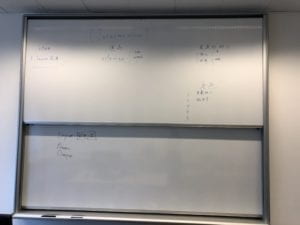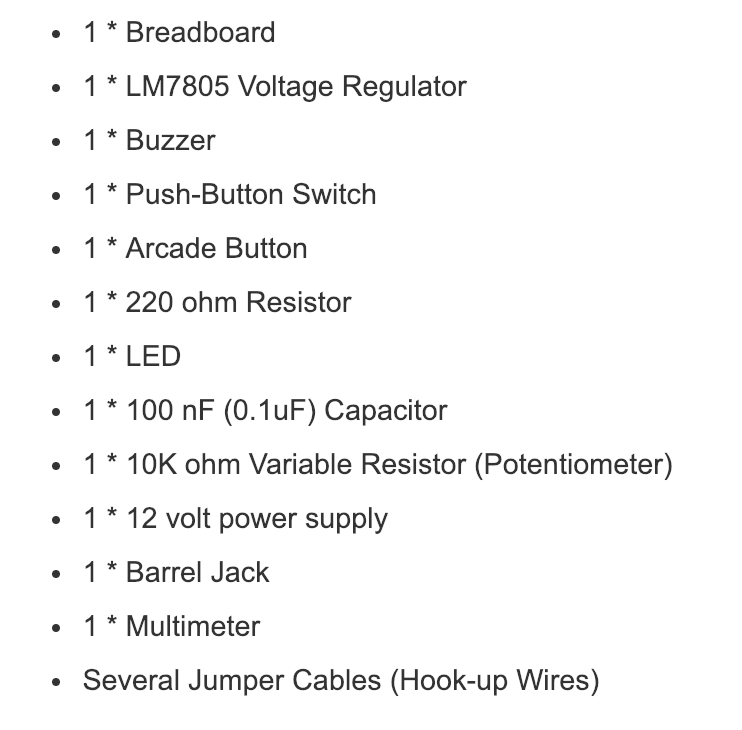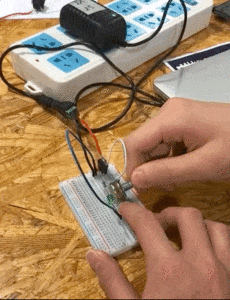My Definition of “Interaction”
A responsive process includes two or more subjects to get input, digest and produce output.
Two Researched Projects
“Pulse Room”

In the beginning, my thought of interaction is the scene like a responsive process happens between two intelligence. However, from the first reading The Art of Interactive Design, I was impressed when the author says if we get academic about the argument, the opening of a fridge is an interaction, in which the fridge listens (to the opening door), thinks (with all the processing power of a single switch), and speaks (by turning on the light). This made me rethink that the main bodies in an interaction are not only “intelligence”, but have the possibility to be anything. Then I saw this project which enhances this possibility and offers me new ideas. It is named “Pulse Room” which can record your pulse and add it to one of the bulbs that in all show 100 people’s pulse at the real-time. This is also an interactive project that not only for intelligence. It shows the interaction between people and the device. They used the sensor to make their output to make the device get input. After digest, which in this case might include the transformation of the signal, the device produces output that is the shinning of the bulbs with the same frequency of the participants’ pulse. Moreover, this project also shows the interaction among these 100 people. Though you can not see them face to face, the pulse reflecting on the bulb provides another possibility to connect with each other.
“Deaf People Hearing For The First Time”

Young showed this video in the class and it impressed me because of the reactions of those deaf people. The rapid development of technology makes us have a deeper and deeper connection with our “machines”. But we almost forget that the most common interaction is between people. With this device, deaf people can have the chance to interact with others in a way that is not surprising for us normal people. The way is the conversation. I regard it as the most obvious interaction in our daily life. We hear as getting the input, think as digesting, and speak as producing output. It was hard for the deaf to have this interaction but now it is possible. This project shaped my definition of interaction that the process within the interaction should be responsive but not only a circle. How we interact in the process does matter. Also, though the machine the deaf use in the video seems more like an intermediary, itself also includes an interaction. It gets input that is other people’s saying, digesting as transforming speaking language into another signal and produce output to make the deaf understand.
Evaluation and Reflection
Upon these two researched projects, I think the second project’s approach aligns better. It tells us more about the meaning of “responsive” and shows us more clearly about the process of getting input, digesting, and producing output. Moreover, it shows us the possibility of doing something helpful to society under the word “Interaction”. Though the first project may approach less well to my definition, it also shows another possibility that we can add elements of “interaction” into the art.
Group Project

For our group project, we first gathered together to discuss our understanding of “interaction” and how to show this “interaction” on a specific device or process that will appear 100 years later. We reached an agreement that interaction includes input, digest, and output. So we came to think which part will be changed in the future. I mentioned the film Matrix that all the interaction might only happen in our mind in the future. However, I have the same idea with the betrayer in the film that I don’t want to abandon my physical enjoyment. I still want to drink a bubble tea in real instead of receiving a brain wave. So we decided to change the input. But how to change?
One slogan mentioned in the reading Introduction to Physical Computing is that we need to make “computers for the rest of you”. Nowadays, our innovation of interaction focuses on the rest of our body. The truth is the controller of our body is our brain. So we suppose that in the future, people will focus on the core of the body, which is the brain. Instead of actually doing something by our body, we can give machines the input just through our brain wave. The digesting will not disappear but will be improved. We think there will be devices to change our brain wave to the digital signal. Also, there will be AI to make the digesting faster and more personalized. However, the output will not change. People still get their commodities or service in real.

After ensuring what we want to express, we started to think about how we can show the “responsive” process of interaction. We designed two scenes. One is the main character thinks his shoelace is loose. By sending this brain wave to the device on his head, it transforms his brain wave to a digital signal. After receiving the digital signal, his shoe pulls its lace tight itself, which is the output. This sends a physical feeling back to his brain that he feels good. Including all the steps mentioned above, the whole process is “responsive”. The other is when he wants to buy a bubble tea. He just sends a brain wave to the device, which transforms it into a digital signal and sends it to his personal AI. His personal AI then sends another digital signal to the AI in the bubble tea machine. For the choices of bubble tea, these two AIs starts a conversation. This part also includes the interaction between AIs in the future. This interaction is like our daily conversation I mentioned in the second researched project but it is through the network which means there is no sound but only digital signals. Finally, after listening to the recommendation, the main character makes his choice. The same transformation happens in his brain. Through two AIs, he placed an order. Finally, he gets his bubble tea and he feels happy, which is the output. Also, all the steps mentioned can be collected to a whole “responsive” process.



In all, our group project satisfies my definition of interaction because it shows a responsive process that includes getting input, digesting and producing output. We mainly focused on the changes in the input part and the improvements in the digesting part that might happen in the future. The responsive processes were shown through our performance that includes two scenes.
































